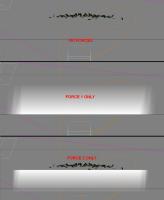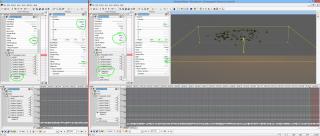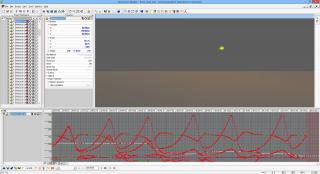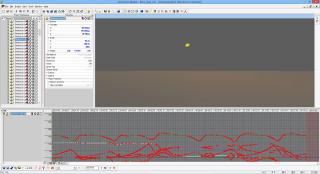-
Posts
21,649 -
Joined
-
Last visited
-
Days Won
119
Content Type
Profiles
Forums
Events
Everything posted by Rodney
-
Believe.
-
Modeling Anna or a similar character is something I've been wanting to do myself if nothing else for the challenge it presents but unfortunately I've over committed myself to other projects (and school) these days. If you get her started and post your progress others (including me) will join in. You can do it! Take a page from Disney and believe in your ability to achieve it. The magic of animation... okay, spline modeling... will do the rest.
-
Well, if you aren't now you soon will be. There's nothing like diving in and creating your own things. That's the purpose of my doodling with splines here, to test out thoughts and theories. Just pace yourself so you don't burn out or get overwhelmed. Keep it fun and before long you'll be able to model anything. I don't know how long you've been modeling with A:M but you very clearly have the talent for it.
-

Workspaces: Saving or somehow using different ones?
Rodney replied to rusty's topic in Animation:Master
I continue to learn something new every day! That is going to be very useful. Rusty, There you have it. Thanks Mack! -
I'm really liking what I'm seeing here. HitFilm Express is very accessible... somewhat unlike After Effects which has assumed more of a Blender-like interface these days. There is no doubt that After Effects is more powerful and versatile but what is power if you cannot readily access it? I hope the folks at HitFilm will be justifiably rewarded for the move to get the word out about their application. I'd certainly never heard of it.
-

Workspaces: Saving or somehow using different ones?
Rodney replied to rusty's topic in Animation:Master
Yes, this is why you can have multiple setups (screen layouts) but when you open a new instance of A:M it will default back to the last layout when A:M was closed. (A:M assumes you went to all that trouble to setup your screen that way so it saves it that way) As I mentioned a workaround for this would be to keep an instance open with an alternate layout (in fact it's sole purpose for being open could be as a 'Please revert back to this layout-saver'. But when you close out that instance the layout of any other instance of A:M still open (and then closed) after that will be maintained. -

Workspaces: Saving or somehow using different ones?
Rodney replied to rusty's topic in Animation:Master
I'm not entirely sure what you mean here. If we move things around in A:M and save... then close either the Project, A:M or both... when we open the project again in A:M it should be in that same screen configuration again. I don't think this is anything new however. As far as I know that's been standard operating procedure. Note: I've heard it reported that Workbook mode is not available for the Mac and have just accepted that as fact as I've no way to test it. Edit: I think I see what you mean. Windows that are not part of the Workbook (those you mention such as Pose Sliders, etc.) aren't saved because they aren't part of the Workbook or Project in the first place. In that regard nothing has changed. As far as I can see, the way to get a Pose relationship window to stick is to create it and leave it open in the Workbook. This works similarly with Actions and Chor windows. I have a vague recollection that you do something a little different in your workflow when it comes to saving. Because of that workflow your workbook settings may not stick. The views of the interface are separate from that of assets in that the interface views are maintained in one session whereas the assets window positions are saved in a Project. I suppose a workaround might be to open more than one instance of A:M as each will maintain the interface windows their own custom locations. -
Installed and operational. Um... there are a lots of things that us bottom feeders can use in this Express Edition of HitFilm. At a quick glance, some things that folks often desire: Easy conversion to/from WMV to other video formats (folks have problems with that conversion) Tracking (Folks want to track things) Compositing and Effects (Folks should be compositing things) etc. I'm liking what I see thus far. What are you waiting for.... go get it! Disclaimer: If the world goes sour because I am now Twittering on Twitter this is all Mark's fault. Note: Upon initial launch I didn't get the menu that allowed activation but after a quick relaunch the menu was there.
-
I'm digging deeper into the project file and have currently locked A:M up in the process so I'll take a break there. Note that after simulation there are some things we can remove from the project. For instance we should be able to remove the Forces without changing any of the animation because every frame of every leaf's every move is keyframed.
-
I switched to the side view for this one... Note the difference in Fall off of the Forces. It's an interesting view of the forces themselves (that white stuff) which can be very handy in shaping forces. When moving back to a front view we see pretty much the same results.
-
There are further differences in the Chor Setup of the Forces position, fall off, etc. Here's a comparison between the two:
-
While there are several differences in the two Forces themselves I'd say the primary difference is the Magnitude which is 5% on Force 1 and the opposite (-5%) on Force 2: So, is it safe to assume that Force 1 might be pushing the leaves along/outward while Force 2 is pulling/drawing the leaves inward? Hmmm... thus far it looks like that could be what they are doing.
-
The only initial difference *in the Sine wave* of the two forces is the Octave. In the first Force the Octave is set to 5 while the second Force's Octave is set to 1. Of course there are other differences in the two Forces themselves.
-
I don't think I'd want to animate each of those leaves manually! Here's a look at the simulated results on one leaf (in the timeline): We might expect to see each leaf's path is different as it is drawn/directed via the two forces. Edit: And of course they are. Added a view of a second randomly selected leaf's timeline.
-
The primary motivators of the action appear to be: - Sine Wave setting of each Force - An expression that controls the Magnitude of the Force (Note that it is Random and in the negative which I assume draws the leaves toward it rather than repel them) Specifically it is: Magnitude=Rand()*-10
-
Yes, a very nice effect! I've never played with that project file so I'm glad you've brought it to the top of the forum again. As for deconstructing/reconstructing... we'll have to look further into it.
-
It does look more like a feature than a bug. Kind of like a point cloud matrix/interface for animating the character. I haven't run into this yet... I'm kind of jealous.
-

Sports Day (2014 Open Games) February
Rodney replied to Simon Edmondson's topic in Contests/Challenges
Here's a training video that breaks the Snatch Lift down into 6 phases: wfLV0MnRVZM?t=58s Phase 1: The pull from the ground Phase 2: The explosive triple extension of the ankles, knees and hips (standing up to full height) Phase 3: The powerful shrug of the shoulders up toward the ears Phase 4: The pull of the arms upwards, keeping the elbows high and out to the side and the bar close to the body Phase 5: The rapid drop under the bar into an overhead squat position, locking the arms out and keeping the arms rotated forward Phase 6: Driving back up to a stable standing position I like how this recipe/formula mirrors our approach to animation by establishing key poses/milestones to hit for the performance by breaking down distinctly different phases/phrases of action into small but important elements in order to achieve a specific goal with a consistent flow, progression and (storytelling) finality. Note also that this weightlifter is something of the opposite of the former one shown by Simon in that she is hardly a monstrous hulk and yet the same technique applies to her actions. Hey! Reusable action! -
If anyone is interested, I'm currently Beta testing an online tool called RGBnotes. Simon recently posted a refernence video of a weight lifter that would be great for testing the RGBnotes annotation and onionskinning modes. So I might use that video for the purpose of sharing RGBnotes with folks here on the forum. (To join the Beta, projects are simply shared with others via an email) The program is very basic....very basic... at this point but the creators hope to make it a very useful collaborative tool and have started adding features. At any rate, during the beta period the way to get other people into the program is to share a project with someone via email. If anyone is interested... share your email address and I'll share a project with you. Disclaimer: I did say the program is very basic... very basic... right? Everything has to start somewhere and the folks at RGBnotes are slowly and steadily moving forward. If interested in joining the RGBnotes Beta just drop me an email (so I have your preferred email) at: rodney.baker@gmail.com Titling it "RGBnotes" or something similar will help also. Note: If you don't care for tools in their early stage of development and beta testing in general it'll be best to pass on this one. If you want to get in on cool tools and workflows, beta testing is a good way to go. As for RGBnotes itself the video playback is quite good and yields smooth scrubbing for me. Initially I had problems drawing over video with any browser (this now works but I'm not sure what fixed it... clearing out my cache as far as I could determine) Currently I can draw in most browsers but... except Chrome... very odd... I'll have to clear my cache again to see if that is the culprit. The problem with drawing may have been related to installation of a mouse/macro recording tool. At any rate, why I couldn't draw before is still a mystery. RGBnotes recently added the onion skinning tool so that you can see preceding and trailing keyframed annotations.
-

Sports Day (2014 Open Games) February
Rodney replied to Simon Edmondson's topic in Contests/Challenges
This is an aspect of balance/anticipation/movement/force that occurs in real life that Milt Kahl, the legendary Disney animator, mastered in classic animation. I note how that as the man's head and upper body moves downward even his legs and feet are moving (jumping) upward. This is an element of 'Opposing Forces' but oh so very much more. This is surely an important technique for the weight lifter in that by squashing his body so much he generates a huge amount of power to continue the upward movement of the weighted bar. I also note that the movement of that bar (and weights) is steady all the way from bottom to top. And... some nice settling in at the end as the weight finds it's equilibrium as it locks into place against precisely placed muscle and bone. I think the final stance the weightlifter is in where he's locked everything in place above him could be termed 'beautiful'. The whole sequence... so realistic! hehe This is a great reference to study for animation. Thanks for sharing it with us. -
With your talent you would have her modeled in no time. Heck, in another topic I think you already had her almost modeled (it was actually another girl model but... hey... it'd be easier for you to modify to look like Anna) Just start a new topic in the WIP section and off you go! We'll be here to cheer you on.
-
I didn't know we had a 3MB upload limit. If that is the case for you some setting is wrong some place.
-
Hi John and welcome to the forum! First, I apologize for your post not showing up... temporary glitch in the system. Hopefully corrected now. Regarding the Copy/Paste issue: I don't recall ever having problems with copy/paste working so I'm at a loss here. I'm not entirely sure what you might be seeing but make sure that A:M isn't copy/pasting directly over the top of your previous splines or that you are in a view that is displaying patches but not splines. For example: If you select a spline from a model that is showing in the modeling window (in shaded view) and paste that back into your model as a spline you won't see the spline. The way to see the spline would be to change to wireframe or shaded wireframe view. There are two ways to do this: Right Click and select View/Shaded Wireframe or use the shortcut number keys at the top of your keyboard to toggle through the views (7=Default, 8=Wireframe, 9=Shaded and 0=Shaded and Wireframe). The view mode is the only thing I can think of that would keep you from being able to see your splines. If I've ever not been able to see splines that has been the reason for it. As a test you could open a second (empty) model and copy the splines from the first model... move to the new (empty) model... and Control V/paste into that model. Then make sure you are in either wireframe or shaded-wireframe view.
-
A tutorialist's job is never finished.
-
Yes, I was referring to Jeff. She could have many a relative. Read and understood.














